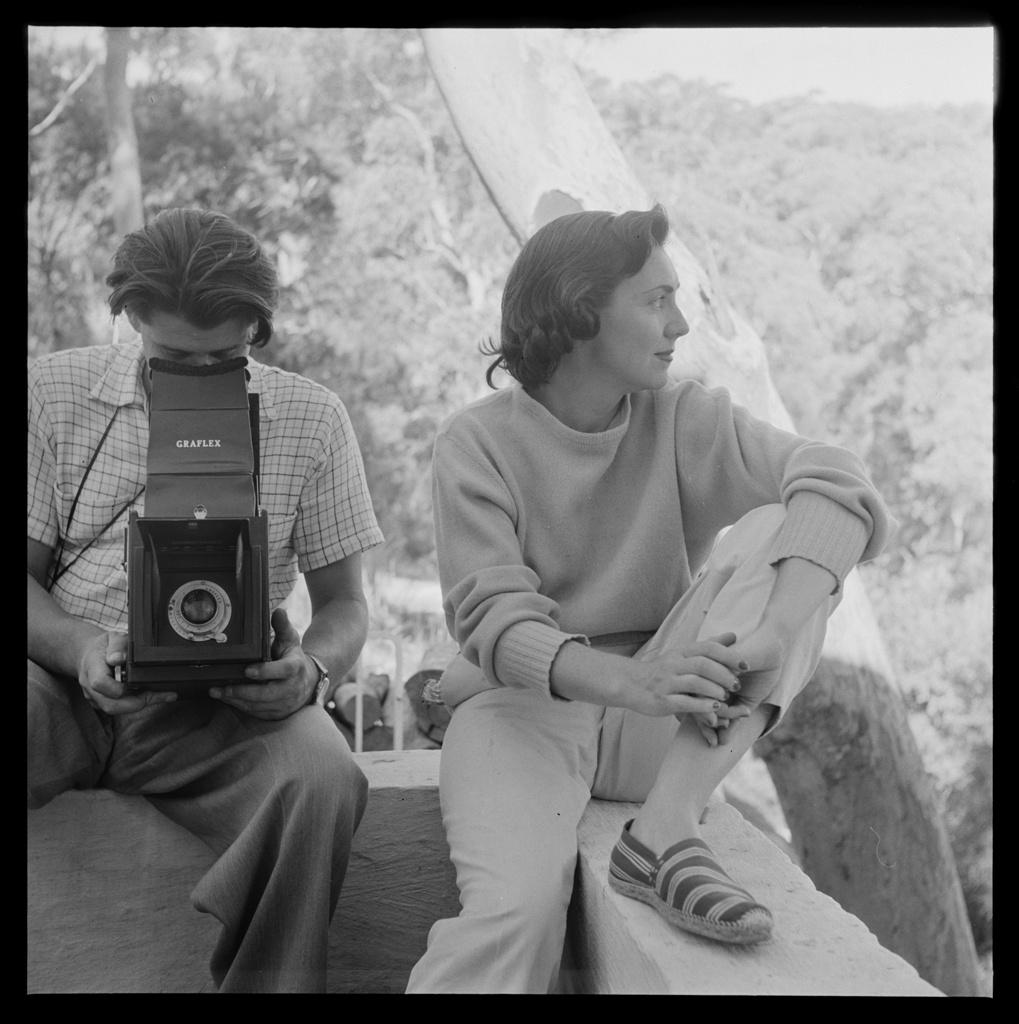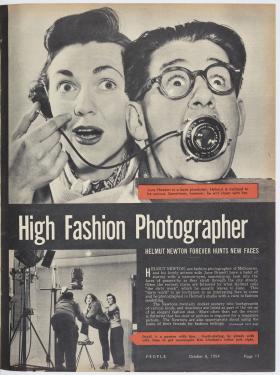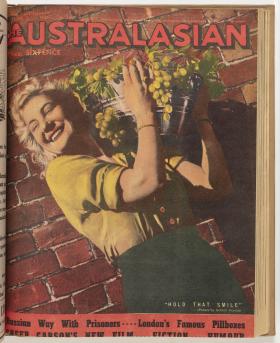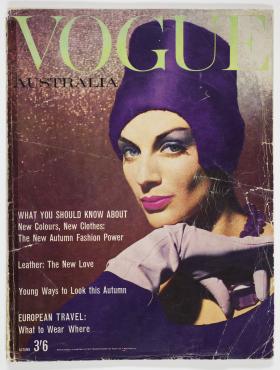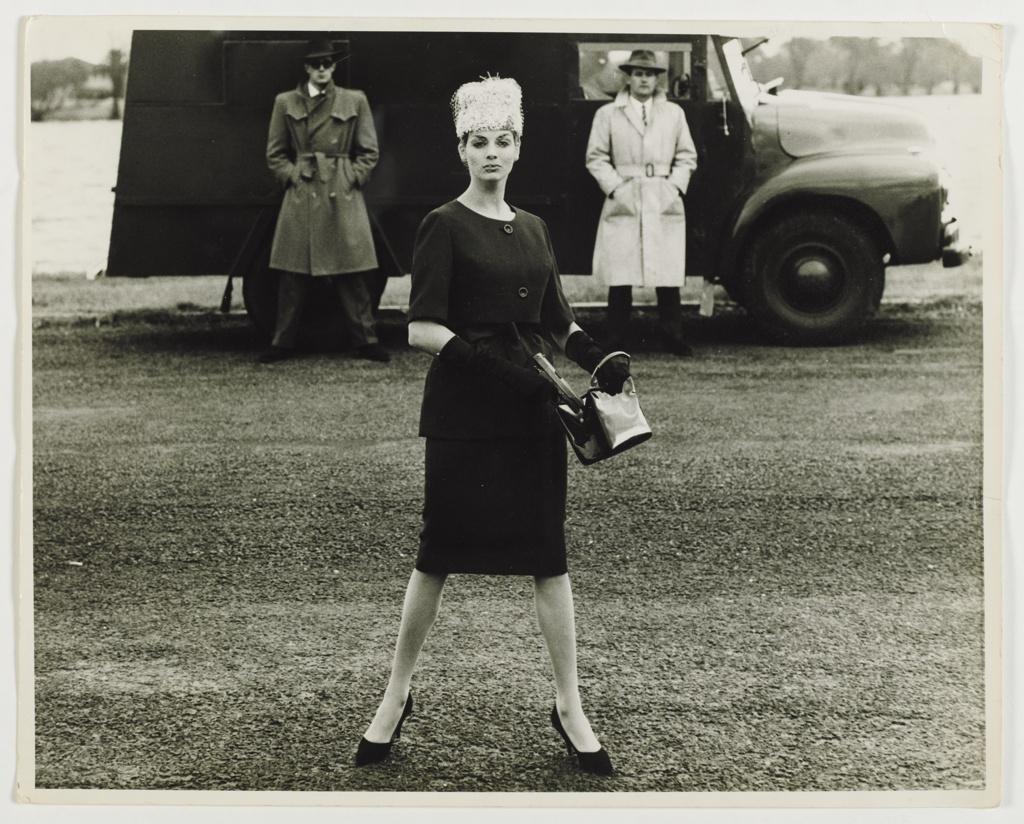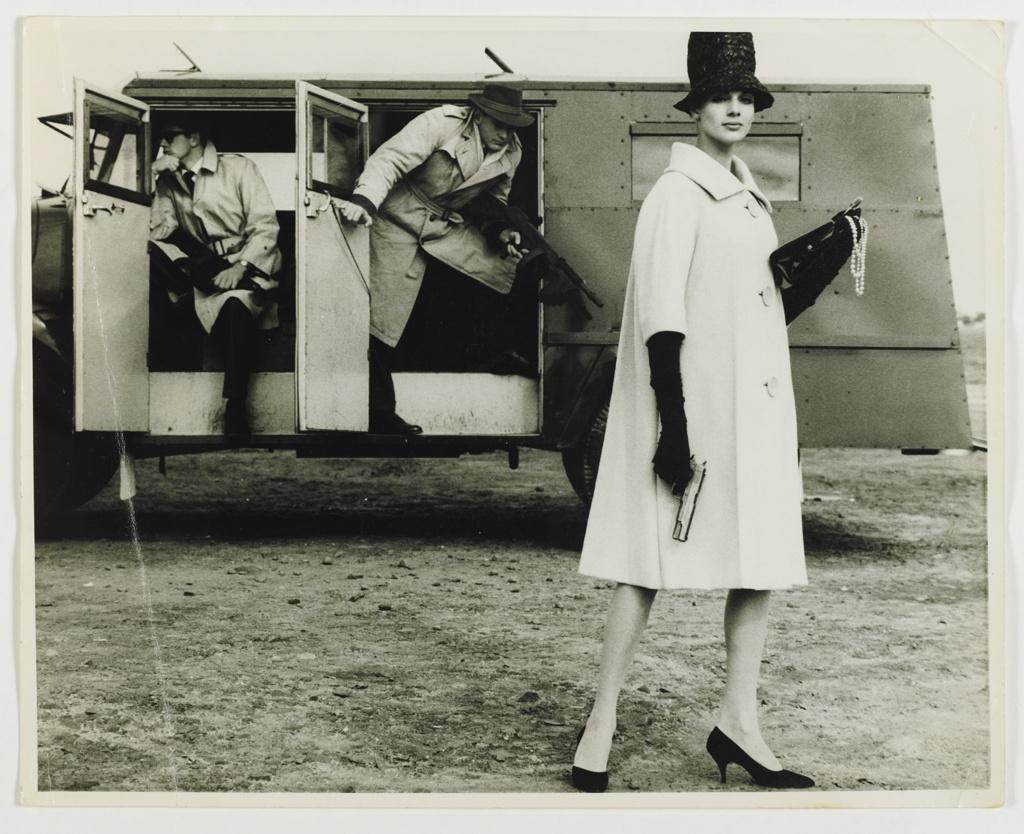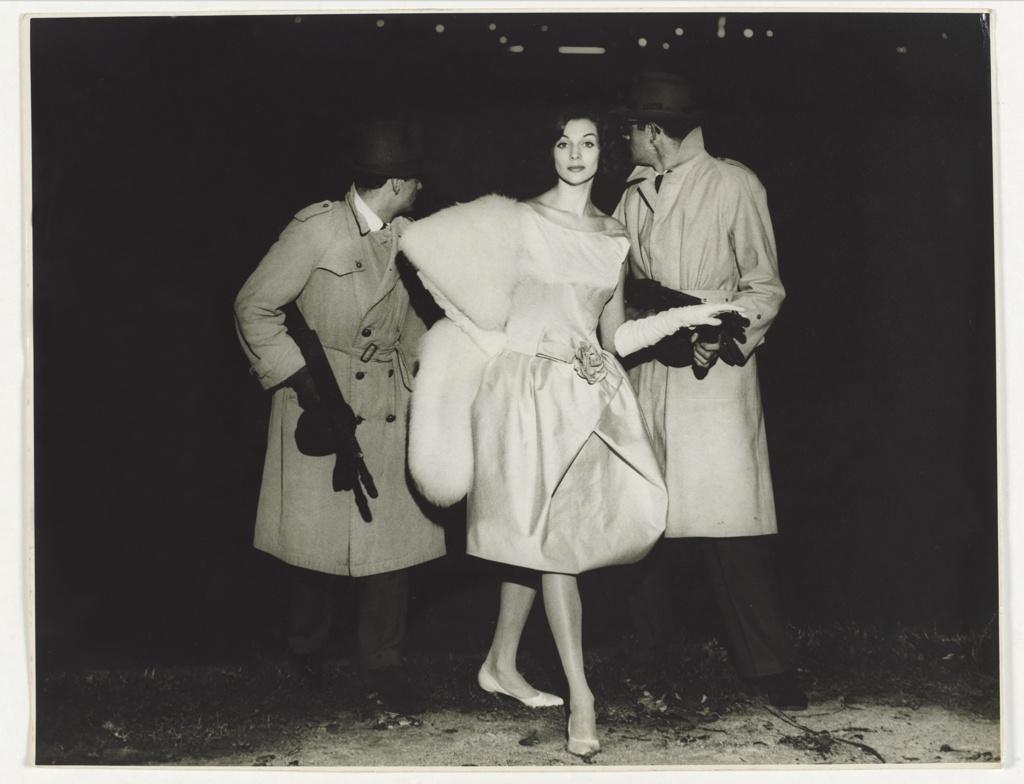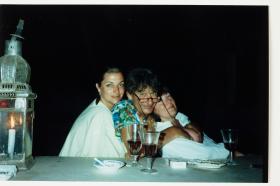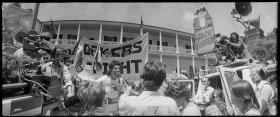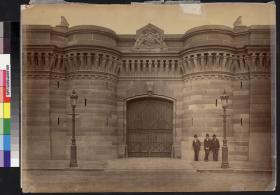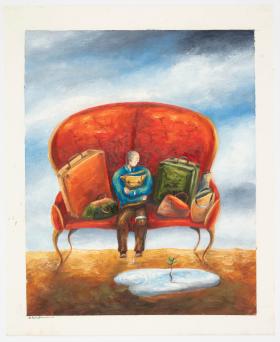They say things happen in threes, and that’s how this investigation began for me. First, browsing the Library’s digital collections, I rediscovered an intriguing set of casual portraits of Helmut Newton — one of the world’s most influential fashion photographers — and his actor wife June, taken in Sydney in the summer of 1955 by legendary Australian photographer Max Dupain at his Castlecrag home.
Few other photographers have been more published than Helmut Newton. His iconic images sold millions of upmarket fashion magazines and have become part of our collective visual memory. Bold, transgressive pictures creating erotically charged tableaux of feminine power, they meld haute couture with high-voltage glamour. Yet few people know that his career began in Australia, not least because Newton’s fashion photography from the 1940s to the early 1960s is rarely found in published surveys or exhibitions.
The second moment was when I read of the death of June Newton in Monte Carlo, at the age of 97. Lifelong muse, collaborator, protector, promoter and curator of her husband’s work, Australian-born June Browne was better known in the 1950s and 1960s by her stage name June Brunell. She became a well-regarded photographer in her own right from 1970, working under the wry pseudonym ‘Alice Springs’.
The third thing happened just as we descended into the mid-2021 lockdown. An enquiry popped into my inbox from the Jewish Museum of Australia in Melbourne, asking about borrowing works by Helmut Newton for a forthcoming exhibition. (HELMUT: In Focus opened in April and will run until early next year.) The JMA show aims to offer the most complete picture of Newton’s life ever exhibited in Australia, so its curator was keen to delve into the photographer’s early career. The Library’s collections include rare copies of Newton’s first magazine spreads, as well as a series of remarkable photoprints shot for a local fashion advertising campaign in 1959. These feature future Model of the Year Maggie Tabberer.
I found myself wondering about the circumstances that brought these four people — Helmut and June and Max and Maggie — together, and about the impact these mid-twentieth century encounters may have had on their lives.
The Newtons left Australia permanently in 1961 and lived a glamourous and cosmopolitan lifestyle. Dupain and Tabberer remained here, each achieving iconic status in their separate spheres but not always so lucky in love; both married twice, and Maggie divorced twice.
During the enforced isolation of lockdown, I browsed widely, searching the many online resources about these high-profile personalities. Helmut, June and Maggie all published autobiographies which I read, looking for evidence of ongoing connections. Max left no biography, though he made notes on his life, about which much has been written.
Most sources make passing reference to the arrival in Australia of Berlin-born Helmut Neustaedter, a Jewish refugee. Leaving Nazi Germany on 5 December 1938, his parents fled to Chile but the self-assured Helmut went his own way. Intending to journey to China, he ended up in Singapore instead. Two years later, with the growing threat from Japan, the 20-year-old left for Australia, travelling on the luxury cruiser Queen Mary, commandeered to transfer enemy aliens to safety. He sailed into Sydney Harbour in September 1940 and later recalled having thoroughly enjoyed the voyage. Transported to the Tatura Internment Camp in rural Victoria, Helmut was released after 16 months. Designated a ‘refugee alien’, he took up civilian war work, including picking fruit, before joining the 6th Employment Company (AMF), driving trucks at Tocumwal. Never without his camera, military service enabled Helmut to mix with ordinary Australians and improve his English. By mid-1946 he was working at a Footscray canning factory and renting a flat in South Yarra.
Discharged on 6 August 1946, Helmut received £100 in deferred pay which enabled him to secure a small, dilapidated top-floor studio space in Flinders Lane, the hub of the Melbourne rag trade. By 4 December 1946, when he changed his name by deed poll to Helmut Newton, he’d already achieved a photo credit to this new name with his first magazine cover — a colour picture of a smiling young woman holding a bucket of grapes for the 2 June 1945 issue of The Australasian. He later recalled his ‘total euphoria’ when he imagined the thousands of people who would buy it.
Newton’s search for commissions that would launch his career as a fashion photographer now began in earnest. ‘From my earliest start as a photographer the printed page was always my goal,’ he said. ‘I realised very early on that the most important factor would be to be published, with a by-line, and that to me was much more important than the money people would pay me for my pictures.’ He also noted that ‘the right girl at the right moment has always been my inspiration’.
That was certainly the case when, in 1946, an aspiring actor named June Browne from the tiny Victorian town of Kangaroo Ground came to his studio looking for modelling work. As their romance blossomed, Helmut would meet June at the theatre after her evening performance and a new avenue of work opened up for him: theatre photography. The couple, known to their friends as ‘Helmie and Junie’, married in May 1948, forming a life partnership which strengthened and endured through the next 57 years, despite Helmut’s warning that she would always be his second love, after photography. June would later say, ‘Photography was always his mistress … [but] I was his wife …’ She recalled their Melbourne years as marvellous: ‘We had no money, but we all had such fun’.
On 6 October 1954, an article in People magazine profiled the Newtons as rising stars in their respective fields. Working together and apart, the couple were said to be constantly on the lookout for interesting locations and fresh faces for Helmut’s fashion modelling business. His ability to infuse his pictures with the utmost chic — ‘using a good honest Australian background and transforming it into something right out of the Champs d’Élysées’ — was credited to his Continental upbringing. Intriguingly, foreshadowing June’s later pseudonymous photographic career, the article also mentions that she had already begun ‘turning out pictures which Helmut says are excellent, though he doesn’t believe that a husband and wife should be in the same line of business’.
Helmut Newton’s grand ambition was to work for Vogue. His growing reputation as an adventurous fashion photographer was rewarded when he secured a commission for a series of Australian supplements to British Vogue showcasing fashions ‘created by Australian designers, worn by Australian models and photographed by … Australian photographer[s] on Australian soil’. Initiated by UK-based fashion editor Rosemary Cooper, who claimed to have discovered Newton ‘working in an attic’, she subsequently commissioned him to shoot fashion spreads and advertisements for the 1954 supplements.
Around this time, Newton received a letter from Max Dupain inviting him and other Melbourne photographers to participate in a group show at Sydney department store David Jones in May 1955. Newton had occasionally exhibited his work in Melbourne to promote photography for advertising and industry, and fashion in particular. Dupain’s Sydney group had been meeting since mid-1954 to discuss and criticise each other’s work and were keen to widen their circle.
As devotees of the New Photography movement that originated in Europe in the 1920s, Newton and Dupain should have had much in common. But, in the telling of his own story, Dupain identified the war years as a turning point for his life and work. He’d begun his career working as an apprentice in the studio of Cecil Bostock, one of Sydney’s top photographers, during an era when the expanding field of magazine illustration meant increased demand for images. Going out on his own in the 1930s, he took on the variety of assignments essential for survival in a commercial studio: advertising, fashion illustration and social portraiture, which supplied a never-ending flow of work. Dupain, a pacifist, served as a camouflage officer between 1941 and 1945, but was devastated by the death of his friend, documentary film maker Damien Parer, and the breakdown of his marriage to teenage sweetheart and studio partner Olive Cotton after only 18 months.
Returning to commercial work in 1947, Dupain was determined to reject the triviality and ‘cosmetic lie’ of fashion photography. He preferred to work outdoors instead of in the studio, which he associated with ‘fakery’. Championing a documentary approach, what he called ‘factual photography’, Dupain began to focus on architectural and industrial photography — both requiring less interaction with people than fashion or portraiture. He said, ‘People are almost out right now — it’s what they make or build that interests me.’
Dupain had remarried in November 1946. From 1953, he lived with his wife, Diana, and their young family at 23 The Scarp, Castlecrag, designed for them by modernist Australian architect Arthur Baldwinson. Built on a steep block sloping down to Middle Harbour, it was surrounded by a native garden cultivated by Dupain. Described by Diana Dupain as a ‘complex character’, Max was not a social person and could be difficult to talk to.
In late 1954, Helmut and June decided to make the 750-mile drive to Sydney for their summer holidays. In her autobiography, June recalls their road trip starting with a traumatic incident: Helmut ran over Cecil, their spotted tabby cat. Named for renowned English fashion and society photographer Ceil Beaton, the cat was something of a Melbourne celebrity in his own right. Posing with June for the Argus photographer in April 1952, he was billed as ‘Cecil, the photogenic cat, who takes pictures’. He had supposedly learned so much about cameras that he was able to ‘release the shutter by tapping it with his paw’.
It’s interesting to imagine how Newton and Dupain, two single-minded and determined photographers, might have spent a day together. While the Castlecrag photoshoot proves that the two photographers did indeed meet, presumably to examine each other’s work and discuss the forthcoming exhibition, nothing came of their proposed collaboration. The eponymously named 6 Photographers show proceeded, displaying over 200 works by the Sydney photographers only — Dupain, Gordon Andrews, Kerry Dundas, Hal Missingham, Axel Poignant and David Potts — after which the group disbanded. There is no evidence that Newton and Dupain ever met again.
Returning to Melbourne to find Cecil thankfully recovered from his trauma, the Newtons were riding the crest of a wave that would soon take them away from Australia. The first issue of the Vogue Supplement for Australia hit local newsstands in March 1955 and Helmut was kept busy working on advertising and editorial commissions for follow-up issues, landing his first full page editorial credit in the Autumn–Winter 1956 Supplement, and his first cover for the Autumn–Winter 1957 issue.
The Newtons left Henry Talbot, a fellow German refugee photographer and former Tatura internee who had joined the Flinders Lane Studio, in charge when they travelled to England to take up a contract with British Vogue in February 1957. But Helmut was unhappy working with the Vogue editors there and broke his contract within a year. The couple moved to Paris in search of more fulfilling assignments before being lured back to Melbourne in late 1958 by a new contract from Condé Nast for Vogue Australia, which launched as a stand-alone title in 1959.
Not surprisingly, this launch increased the volume of Australian fashion photography. Regarded by now as the doyen of Melbourne’s fashion photographers, Newton not only photographed most of Australia’s top models, he discovered quite a few of them. One was Margaret Tabberer, a young wife and mother just beginning her modelling career in her hometown of Adelaide. Working for David Jones there, she met top model Diane Masters who told her, ‘You’ve got to get out of Adelaide … the fashion centre in Australia is in Melbourne and that’s where you belong’. Masters orchestrated her introduction to Newton, who relished working with taller, bigger ‘Amazonian’ models. Newton was immediately drawn to Tabberer’s dark, European-style looks (and great legs), telling fashion buyer Sheila Scotter, who would later become Vogue Australia editor, ‘I’ve found this woman with the most fantastic face, in Adelaide ... [she’s size 14 ... but] you should use her’.
Newton turned Margaret, the housewife, into Maggie, the model. Her face dominated the editorial and fashion advertising pages of Vogue Australia between 1959 and 1961. Newton helped Maggie develop her knowledge of photography and encouraged her involvement, as he had with June, in the styling of his pictures, which ignited a creativity Maggie never knew she had.
Around this time, Melbourne manufacturers Lucas & Co. decided to promote their exclusive fashion range, adapted from designs by Parisian couturier Pierre Cardin, in a series of lavish advertising campaigns featured in Vogue. These would be shot by Australia’s ace fashion photographer, and feature one of Australia’s most recognisable faces.
Maggie remembers Newton saying, ‘I’ve got a concept for Lucas … I want to do it with guys with guns and I want it to look like a big heist has taken place.’ She would hold a handgun and have pearls hanging out of her handbag, ‘like I had just stolen the jewels … ’.
Another photo in the series was shot at night in one of Melbourne’s dark, rainslicked alleyways. Gritty yet elegant, this image has an erotic subtext. Tabberer, swathed in fur, was cast as a gangster’s moll, accompanied by two criminal types in trench coats, her gloved hand stroking the barrel of her henchman’s machine gun. Taking fashion photography out of the studio and onto the street, Newton depicts a modern woman in action. Moreover, his risqué, sophisticated snap gives the Cardin–Lucas cocktail dress a hefty dose of cutting-edge glamour. The photo’s sinister tone is enhanced by Newton’s penchant for film noir and predicts the irreverent style that would become his signature.
In 1961 Tabberer became Vogue Australia’s first local cover girl, appearing on the autumn issue. She was named 1960 Model of the Year but the demands of her modelling career saw the end of her marriage. Among Tabberer’s papers at the Library are black and white contact sheets taken by Newton showing beautiful shots of Maggie nude, wrapped in sheets with her hair down. As Maggie recalls, their affair ‘seemed very natural … We spent so much time together in all sorts of situations.’ Much later, Helmut told Maggie that when he’d confessed to June, she’d said she didn’t blame him. But the romance came to an end when the Newtons left the country for good in May 1961, heading to Paris to shoot a 12–page colour advertising spread for Vogue Australia, promoting Melbourne’s House of Prestige.
Sponsored by French airline TAI, and resembling a ravishing travelogue, Newton snapped the garments on French models ‘in the Vogue manner’, using key Parisian sites as backdrops, including the Eiffel Tower, Montmartre and L’Opéra. In her autobiography Maggie recalls that Newton said to her, ‘“You should come” … But I had two little girls who were totally dependent on me ... I knew that it wouldn’t work.’ Tabberer ended her modelling career not long after, at the age of 25. She maintained her friendship with the Newtons and became a household name in Australia through her fashion and television work.
Coming to the end of my investigation, I find I can’t agree with claims by Australian photo historian Gael Newton (no relative) that Helmut Newton ‘left nothing to represent his early work in Melbourne in the 1950s’. Nor with Newton’s close friend Karl Lagerfeld’s description of the decade as Newton’s ‘unknown, mysterious Australian period’. Newton himself declared that he learned nothing in Australia: ‘Absolutely nothing! They were formative years but they didn’t form me.’ Again, I can’t agree with the man himself.
Newton’s Australian years gave him the confidence to pursue his creativity internationally. What he took with him was the earthiness of the girl from Kangaroo Ground who stayed a constant in his life. In June, Newton found a collaborator who truly understood his work. She was crucial to his success, extending the reach of his considerable oeuvre through her encouragement and unwavering support. After Helmut’s death in 2006, June wasn’t drawn back to Australia. She said, ‘the only thing I was ever drawn to was Helmut ... I loved my life in Australia, but ... home was always where Helmut was.’
Margot Riley, curator.
This story appears in Openbook winter 2022.

